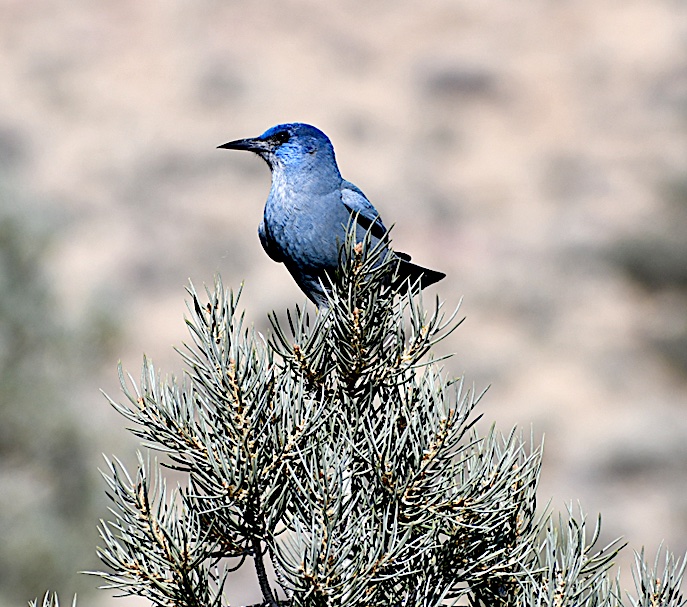Instructor Robin Eppard and student Maile Pierson visit a 2,000-acre study site above Topaz Lake to survey conditions for pinyon jays and their favorite food piñon pine nuts.
Photo by Kurt Hildebrand.
It’s coming up on breeding season for the pinyon jay and the bright blue birds are flocking to the trees around Topaz Lake.
Western Nevada College instructor Robin Eppard and her students have been conducting research on the birds at study sites located on the south face of Wild Oat Mountain and in the Sierra across from the Topaz Lodge for two seasons.
On Oct. 10, she and student Maile Pierson were visiting the 2,000-acre site to check on the birds favorite foods, piñon pine nuts.
The trees are critical to the birds’ survival, which is in question with a request for listing it as endangered before the U.S. Fish & Wildlife Service.
The student research is working to establish a baseline for the trees and birds in the area, Eppard said.
“What we’re trying to do right now is come up with a baseline survey of some parts of the forest we know the pinyon jays use for roosting, for nesting, for foraging or caching,” she said.
 Robin Eppard took this photo of a pinyon jay near Topaz Lake.
Robin Eppard took this photo of a pinyon jay near Topaz Lake.
The southern Douglas County site has a good mix of terrains that provides student researchers for a variety of opportunities.
“In our study area we have a mix of undisturbed forest, cleared for residential use and forest that has been burned,” she said. “There are a lot of different directions we can go with this project over time.”
There were about 100 birds gathering along Highway 395 across from the Lodge on Oct. 17, she said.
Pierson and Eppard were counting pine cones in the piñons to determine what forage will be available to the jays.
“I don’t think we’re going to find many mature cones on this particular stand of trees,” Eppard said.
That spot is on land managed by the Walker River Irrigation District. Eppard said she and her students have permission to be on the site.
The Forest Service required a special use permit for work on that land.
“We’re hands-off at this point,” Eppard said. “We’re just collecting data may change if we find something we need to take.”
Ten Western Nevada students have participated in the research over the last two years where they’ve done everything from checking soil bacteria to measuring trees.
Pierson’s particular area of interest has been piñon pathogens.
“On this site we found piñon ips beetle, twig beetle, red turpentine beetle and one disease, piñon needle rust,” she said.
Pierson was named student researcher of the year at the college in spring 2024.
“It was an amazing opportunity,” she said. “Just to be out in the field, I’ve learned so much about this area where we live and how to do field research.”
Pierson said she’s been learning how to collect data and how to present it, including to the Lahontan Audubon Society.
“When I first stated I was going to pursue medical or wildlife biology,” she said. “They were both so amazing, I’ve had a hard time picking between the two.”
Pierson intends to continue her studies at the University of Nevada, Reno, where three instructors have participated in the research.
“When she told me she was thinking of going into pathology, we changed this summer’s scope, dropped one parameter and added pathology, and Maile owned that all summer,” Eppard said.
Piñon cones take more than two years to mature, starting out as tiny pink cones.
“If they all reach maturity there is a mother lode for the birds to consume,” Eppard said. “If you look up in this tree, you see tiny brown cones. Those aborted at the beginning of this summer. You can see the cones are starting to brown. They are aborting at every stage. Something happened all year long that caused trees to decide we just don’t have the energy to complete growing these cones.”
The jays don’t just eat the pine’s nuts, but they end up putting them places where they can germinate.
“When the pinyon jays cache the seeds in the rocks and also at the base of shrubs, when that germinates it will grow up under the protection of the shrub, called a nurse plant, killing the shrub and replacing it,” Eppard said. “It can take 30 years for a piñon pine to get taller than its nurse shrub.
Determining a piñon pine’s age can be tricky, since a straight-trunked tree around 6 feet tall could be 60 years old.
“Typically a tree that size would be 60-80 years old and just coming into cone-bearing age,” Eppard said. “But these trees are growing faster than the typical piñon pine.”
Comparing trees in the different soil types between Wild Oat Mountain and the Sierra is one of the parameters researchers are working on.
“The geology is different between the Sierra and the Pine Nuts,” she said. “Here the soils are very shallow, whereas over there they are much deeper and it’s a much more successful cone-bearing area.”